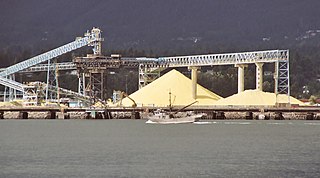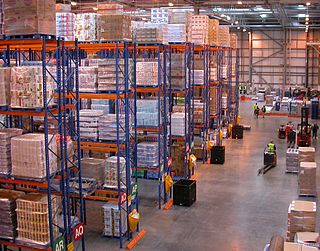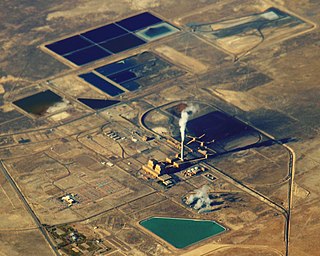This article includes a list of general references, but it lacks sufficient corresponding inline citations .(April 2009) |

A chain conveyor is a type of conveyor system for moving material through production lines.
This article includes a list of general references, but it lacks sufficient corresponding inline citations .(April 2009) |

A chain conveyor is a type of conveyor system for moving material through production lines.

Chain conveyors use an endless chain both to transmit power and to propel material through a trough, either pushed directly by the chain or by attachments to the chain. The chain runs over sprockets at either end of the trough. Chain conveyors are used to move material up to 90 metres (300 ft), and typically under 30 metres (98 ft). [1] : 271
Chain conveyors utilize a powered continuous chain arrangement, carrying a series of single pendants.[ citation needed ] The chain arrangement is driven by a motor, and the material suspended on the pendants are conveyed. Chain conveyors are used for moving products down an assembly line and/or around a manufacturing or warehousing facility.
Chain conveyors are primarily used to transport heavy unit loads, e.g. pallets, grid boxes, and industrial containers. These conveyors can be single or double chain strand in configuration. The load is positioned on the chains, the friction pulls the load forward. [2] Chain conveyors are generally easy to install and have very minimum maintenance for users.
Many industry sectors use chain conveyor technology in their production lines. The automotive industry commonly uses chain conveyor systems to convey car parts through paint plants. [3] Chain conveyors also have widespread use in the white and brown goods, metal finishing and distribution industries. Chain conveyors are also used in the painting and coating industry, this allows for easier paint application. The products are attached to an above head chain conveyor, keeping products off of the floor allows for higher productivity levels.
Types of chain conveyor include apron, drag, plain chain, scraper, flight, and en-masse conveyors. [1] : 271
Drag conveyors, variously called drag chain conveyors, scraper chain conveyors and en-masse conveyors, are used in bulk material handling to move solid material along a trough. They are used for moving materials such as cement clinker, ash, and sawdust in the mining and chemical industries, [4] municipal solid waste incinerators, [5] and the production of pellet fuel. [6]
The difference between drag conveyors, scraper conveyors, and flight conveyors largely depends on whether the chain links have obvious flights or paddles attached. [4] In a drag conveyor, the chain moves the material directly, while a flight conveyor uses a series of wood, metal, or plastic flights attached to the chain at regular intervals, which push the material along the trough. [7]

Multiflexing conveyor systems use plastic chains in many configurations. The flexible conveyor chain design permits horizontal as well as vertical change of direction.[ citation needed ]

A conveyor belt is the carrying medium of a belt conveyor system. A belt conveyor system is one of many types of conveyor systems. A belt conveyor system consists of two or more pulleys, with a closed loop of carrying medium—the conveyor belt—that rotates about them. One or both of the pulleys are powered, moving the belt and the material on the belt forward. The powered pulley is called the drive pulley while the unpowered pulley is called the idler pulley. There are two main industrial classes of belt conveyors; Those in general material handling such as those moving boxes along inside a factory and bulk material handling such as those used to transport large volumes of resources and agricultural materials, such as grain, salt, coal, ore, sand, overburden and more.

A reclaimer is a large machine used in bulk material handling applications. A reclaimer's function is to recover bulk material such as ores and cereals from a stockpile. A stacker is used to stack the material.

A distribution center for a set of products is a warehouse or other specialized building, often with refrigeration or air conditioning, which is stocked with products (goods) to be redistributed to retailers, to wholesalers, or directly to consumers. A distribution center is a principal part, the order processing element, of the entire order fulfillment process. Distribution centers are usually thought of as being demand driven. A distribution center can also be called a warehouse, a DC, a fulfillment center, a cross-dock facility, a bulk break center, and a package handling center. The name by which the distribution center is known is commonly based on the purpose of the operation. For example, a "retail distribution center" normally distributes goods to retail stores, an "order fulfillment center" commonly distributes goods directly to consumers, and a cross-dock facility stores little or no product but distributes goods to other destinations.

Bulk material handling is an engineering field that is centered on the design of equipment used for the handling of dry materials. Bulk materials are those dry materials which are powdery, granular or lumpy in nature, and are stored in heaps. Examples of bulk materials are minerals, ores, coal, cereals, woodchips, sand, gravel, clay, cement, ash, salt, chemicals, grain, sugar, flour and stone in loose bulk form. It can also relate to the handling of mixed wastes. Bulk material handling is an essential part of all industries that process bulk ingredients, including: food, beverage, confectionery, pet food, animal feed, tobacco, chemical, agricultural, polymer, plastic, rubber, ceramic, electronics, metals, minerals, paint, paper, textiles and more.

In civil engineering, a wheel tractor-scraper is a type of heavy equipment used for earthmoving. It has a pan/hopper for loading and carrying material. The pan has a tapered horizontal front cutting edge that cuts into the soil like a carpenter's plane or cheese slicer and fills the hopper which has a movable ejection system. The horsepower of the machine, depth of the cut, type of material, and slope of the cut area affect how quickly the pan is filled.

Bulk cargo is commodity cargo that is transported unpackaged in large quantities.

Bottom ash is part of the non-combustible residue of combustion in a power plant, boiler, furnace or incinerator. In an industrial context, it has traditionally referred to coal combustion and comprises traces of combustibles embedded in forming clinkers and sticking to hot side walls of a coal-burning furnace during its operation. The portion of the ash that escapes up the chimney or stack is, however, referred to as fly ash. The clinkers fall by themselves into the bottom hopper of a coal-burning furnace and are cooled. The above portion of the ash is also referred to as bottom ash.

A screw conveyor or auger conveyor is a mechanism that uses a rotating helical screw blade, called a "flighting", usually within a tube, to move liquid or granular materials. They are used in many bulk handling industries. Screw conveyors in modern industry are often used horizontally or at a slight incline as an efficient way to move semi-solid materials, including food waste, wood chips, aggregates, cereal grains, animal feed, boiler ash, meat, and bone meal, municipal solid waste, and many others. The first type of screw conveyor was the Archimedes' screw, used since ancient times to pump irrigation water.
Automated Truck Loading Systems - ATLS has been commonly used in the material handling industry to refer to the automation of loading or unloading trucks and trailers with product either on or without pallets, slip sheets, racks, containers, using several different types of automated guided vehicle systems (AGV) or engineered conveyor belt systems that are integrated into vehicles, automating the shipping / receiving and logistics operations.

Material handling equipment (MHE) is mechanical equipment used for the movement, storage, control, and protection of materials, goods and products throughout the process of manufacturing, distribution, consumption, and disposal. The different types of equipment can be classified into four major categories: transport equipment, positioning equipment, unit load formation equipment, and storage equipment.

A conveyor system is a common piece of mechanical handling equipment that moves materials from one location to another. Conveyors are especially useful in applications involving the transport of heavy or bulky materials. Conveyor systems allow quick and efficient transport for a wide variety of materials, which make them very popular in the material handling and packaging industries. They also have popular consumer applications, as they are often found in supermarkets and airports, constituting the final leg of item/ bag delivery to customers. Many kinds of conveying systems are available and are used according to the various needs of different industries. There are chain conveyors as well. Chain conveyors consist of enclosed tracks, I-Beam, towline, power & free, and hand pushed trolleys.

Jervis B. Webb Company is a global company that designs, engineers, installs and supports integrated material handling systems such as baggage handling systems, Automatic Guided Vehicles (AGVs), conveyor systems and Automated Storage and Retrieval Systems (AS/RS). Webb is a subsidiary of Daifuku Co., Ltd.

Material handling involves short-distance movement within the confines of a building or between a building and a transportation vehicle. It uses a wide range of manual, semi-automated, and automated equipment and includes consideration of the protection, storage, and control of materials throughout their manufacturing, warehousing, distribution, consumption, and disposal. Material handling can be used to create time and place utility through the handling, storage, and control of waste, as distinct from manufacturing, which creates form utility by changing the shape, form, and makeup of material.

Superior Industries, Inc. is an American manufacturing company headquartered in Morris, Minnesota. The company engineers, manufactures, sells and supports dry bulk processing and handling equipment and components. In 2008, Superior acquired Westmor Industries, a manufacturer and distributor of energy storage, transportation and dispensing equipment also headquartered in Morris.
Heyl & Patterson Inc. is an American specialist engineering company, founded in 1887 and based in Pittsburgh, Pennsylvania.

A shiploader is a large machine used for continuously loading bulk solid materials such as iron ore, coal, fertilizers, grains and/or material in bags onto ships or barges. These machines are located in ports and jetties to facilitate bulk material exportation. Generally shiploaders are engineered to suit specific project requirements. Those requirements often include: port design, material characteristics, loading capacity, vessel type, local law, and budgetary limitations. A shiploader mainly consists of a central column, an extendable arm or boom, a belt conveyor extending out of the boom structure, a slewing mechanism, and a loading chute to transfer product from a source conveyor or feeder. The boom can move front and back, up and down by separate drives so that it can fill the whole breadth of the ship hold and adapt to the ships increasing draught while it is loaded.

A conveyor chain is chain that has been designed specifically for chain conveyor systems. It consists of a series of journal bearings that are held together by constraining link plates. Each bearing consists of a pin and a bush on which the chain roller revolves.

Joy Global Inc. was a company that manufactured and serviced heavy equipment used in the extraction and haulage of coal and minerals in both underground and surface mining. The company had manufacturing facilities in Alabama, Pennsylvania, Texas, Wisconsin, Australia, Canada, China, France, South Africa, Poland and the United Kingdom. In 2017, Joy Global was acquired by Komatsu Limited and was renamed Komatsu Mining Corp.

TAKRAF India Private Limited is a wholly owned subsidiary of TAKRAF GmbH. As with its parent company, TAKRAF India provides equipment, systems and services to the mining and associated industries through the TAKRAF and DELKOR brands.
Chain Belt Company was an agricultural equipment manufacturer in the US. It produced chain belts specifically to replace leather-based belts, which were used inside engine-powered agricultural equipment at the time.